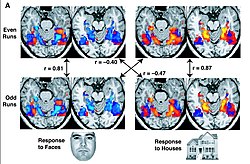Functional magnetic resonance imaging
Functional Magnetic Resonance Imaging (fMRI) is a special type of MRI that makes it possible to watch different areas of a person's brain while they do different tasks.[1]
A functional MRI shows the use of oxygen in different brain areas. The Deoxyhemoglobin in blood absorbs a radiowave signal and later emits it (sends it back out). Oxyhemoglobin does not. When an area of the brain is active, the blood flow to that area increases and more oxyhemoglobin is delivered to supply the active cells with oxygen. This means less of the signal is absorbed. An active area of the brain absorbs and emits less energy than a less active area. This can be seen live as it is happening when different areas of the brain 'light up' on the images as they become less active.
Functional Magnetic Resonance Imaging Media
fMRI image of the brain of a participant in the Personal Genome Project
References
- ↑ "What Is FMRI? - Center for Functional MRI - UC San Diego". cfmriweb.ucsd.edu. Archived from the original on 2020-06-22. Retrieved 2020-06-11.
Books
- Richard B. Buxton, Introduction to functional magnetic resonance imaging: Principles and techniques, Cambridge University Press, 2002, ISBN 0-521-58113-3





